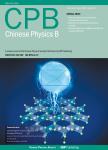Conductive property of Zr_(0.1)Fe_(0.9)V_(1.1)Mo_(0.9)O_7 with low thermal expansion
Conductive property of Zr_(0.1)Fe_(0.9)V_(1.1)Mo_(0.9)O_7 with low thermal expansion作者机构:North China University of Water Resources and Electric Power Henan Key Laboratory of Photovoltaic Materials Henan University
出 版 物:《Chinese Physics B》 (中国物理B(英文版))
年 卷 期:2019年第28卷第5期
页 面:244-248页
核心收录:
基 金:Project supported by the National Natural Science Foundation of China(Grant Nos.11574276,51702097,and 11574083) the Program for Innovative Research Team(in Science and Technology)in University of Henan Province,China(Grant No.16IRTSTHN017) Henan Science and Technology Development Project,China(Grant No.182102210241)
主 题:low thermal expansion conductivity thermal excitation electric impedance
摘 要:Low thermal expansion materials are mostly ceramics with low conductive property, which limits their applications in electronic devices. The poor conductive property of ceramic ZrV_2 O_7 could be improved by bi-substitution of Fe and Mo for Zr and V, accompanied with low thermal expansion. Zr_(0.1) Fe_(0.9) V_(1.1 )Mo_(0.9 )O_7 has electrical conductivity of 8.2× 10^(-5) S/cm and 9.41× 10^(-4) S/cm at 291 K and 623 K, respectively. From 291 K to 413 K, thermal excitation leads to the increase of carrier concentration, which causes the rapid decrease of resistance. At 413–533 K, the conductivity is unchanged due to high scattering probability and a slowing increase of carrier concentration. The conductivity rapidly increases again from533 K to 623 K due to the intrinsic thermal excitation. The thermal expansion coefficient of Zr_(0.1) Fe_(0.9) V_(1.1 )Mo_(0.9 )O_7 is as low as 0.72× 10^(-6 )K^(-1) at 140–700 K from the dilatometer measurement. These properties suggest that Zr_(0.1) Fe_(0.9) V_(1.1 )Mo_(0.9 )O_7 has attractive application in electronic components.



